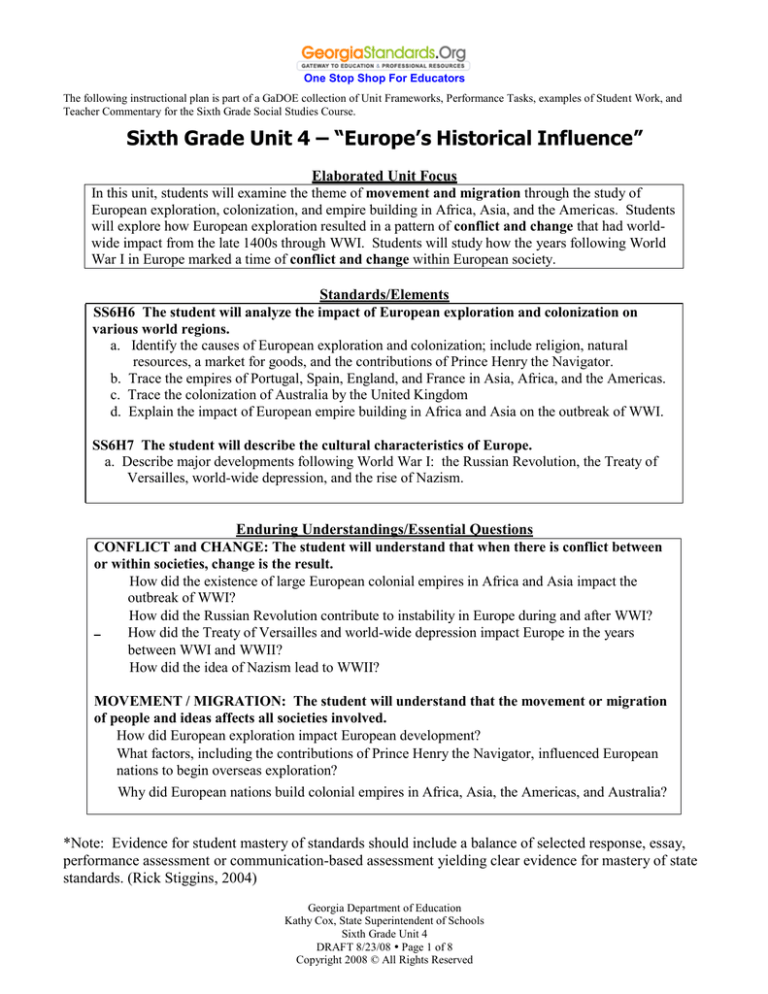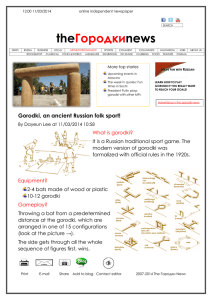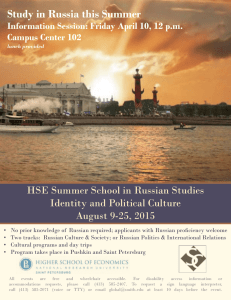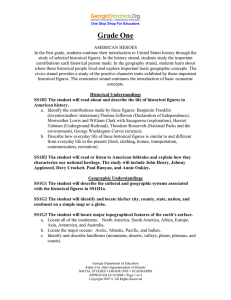
One Stop Shop For Educators
The following instructional plan is part of a GaDOE collection of Unit Frameworks, Performance Tasks, examples of Student Work, and
Teacher Commentary for the Sixth Grade Social Studies Course.
Sixth Grade Unit 4 – “Europe’s Historical Influence”
Elaborated Unit Focus
In this unit, students will examine the theme of movement and migration through the study of
European exploration, colonization, and empire building in Africa, Asia, and the Americas. Students
will explore how European exploration resulted in a pattern of conflict and change that had worldwide impact from the late 1400s through WWI. Students will study how the years following World
War I in Europe marked a time of conflict and change within European society.
Standards/Elements
SS6H6 The student will analyze the impact of European exploration and colonization on
various world regions.
a. Identify the causes of European exploration and colonization; include religion, natural
resources, a market for goods, and the contributions of Prince Henry the Navigator.
b. Trace the empires of Portugal, Spain, England, and France in Asia, Africa, and the Americas.
c. Trace the colonization of Australia by the United Kingdom
d. Explain the impact of European empire building in Africa and Asia on the outbreak of WWI.
SS6H7 The student will describe the cultural characteristics of Europe.
a. Describe major developments following World War I: the Russian Revolution, the Treaty of
Versailles, world-wide depression, and the rise of Nazism.
Enduring Understandings/Essential Questions
CONFLICT and CHANGE: The student will understand that when there is conflict between
or within societies, change is the result.
How did the existence of large European colonial empires in Africa and Asia impact the
outbreak of WWI?
How did the Russian Revolution contribute to instability in Europe during and after WWI?
How did the Treaty of Versailles and world-wide depression impact Europe in the years
between WWI and WWII?
How did the idea of Nazism lead to WWII?
MOVEMENT / MIGRATION: The student will understand that the movement or migration
of people and ideas affects all societies involved.
How did European exploration impact European development?
What factors, including the contributions of Prince Henry the Navigator, influenced European
nations to begin overseas exploration?
Why did European nations build colonial empires in Africa, Asia, the Americas, and Australia?
*Note: Evidence for student mastery of standards should include a balance of selected response, essay,
performance assessment or communication-based assessment yielding clear evidence for mastery of state
standards. (Rick Stiggins, 2004)
Georgia Department of Education
Kathy Cox, State Superintendent of Schools
Sixth Grade Unit 4
DRAFT 8/23/08 Page 1 of 8
Copyright 2008 © All Rights Reserved
One Stop Shop For Teachers
*NOTE: The balanced assessment plan included in this unit is presented as a series of suggested
activities. It is not expected that the teacher complete all assessments for a successful unit.
Balanced Assessment Plan
Description of Assessment
The students will research the contributions of Prince Henry the
Navigator to European exploration and colonization.
Standard/
Element
SS6H6a,b,c
Type of
Assessment
*Constructed
Response
*Observation
SSH6a,b,c,d
*Constructed
Response
*Dialogue &
Discussion
*Observation
Using a blank map, students will use different colors to denote
the empires of Portugal, Spain, England and France in Africa, the
Americas, Asia, and Australia.
After the map activity is completed, students will choose one of
the European countries above and write a one paragraph analysis
of the affects of empire-building on that country. The paragraph
will be written in first-person as the student takes on the role of
the country. For example, ―I am Spain. I was a leader in empirebuilding during…… I established an empire in …‖ Other
questions can include: ―If it hadn’t been for me…. And I am most
like
, another empire- building country, because we both
From An Instructional Guide: Europe In Transition.
Blankenship, Brown, Kaufmann, et al. Southern Center for
International Studies. Atlanta, GA (2002).
Lesson Six / Activity 1: What are the legacies of European
colonialism?
Students will examine European colonialism in major world
regions and analyze the implications of this involvement.
Between the 16th and 20th centuries, several European states rule,
and lost, large empires around the world. By the end of the
1970s, almost every former European colony had gained
independence. Although European states no longer control the
affairs of former colonies in Africa, Asia, the Americas, the
Middle East, and elsewhere, in many cases former colonial
powers continue to have a strong influence in the countries they
once governed. This activity allows students to examine
European colonialism and analyze its implications.
To begin this activity, divide the class into six groups, two groups
for each of the following reasons: Africa, Asia, and the
Americas. Distribute to each student the following:
Worksheet 6.1, ―Europe’s Colonial Empires.‖
Georgia Department of Education
Kathy Cox, State Superintendent of Schools
Sixth Grade Unit 4
DRAFT 8/23/08 Page 2 of 8
Copyright 2008 © All Rights Reserved
One Stop Shop For Teachers
Also, distribute to the groups one copy of the following:
Handout 6.1, ―European Colonial Holdings in Around the
World,‖
Handout 6.2 ―Europe’s Colonial History,‖ and
Handout 6.3 ―Legacies of European Colonialism.‖
First, have the groups use the handouts as they fill in their graphic
organizers/worksheets.
Next, have each group brainstorm responses to the following
question ―Was European colonialism a positive or negative
experience for the colonies in your region?‖
Possible Differentiation To Enrich this Activity
Distribute to each group the primary document in Handout 6.4,
―Historical Documents Concerning European Colonialism,‖ that
corresponds to their region and Handout 6.2 ―Questions for
Historical Documents.‖ After the students have had a chance to
review their document and fill in Handout 6.2, student groups
should be encouraged to write down any additional ideas or
questions they have concerning the legacies of European
colonialism. Review the documents, Handout 6.2, and student
questions generated in class discussion.
Teachers can conclude this part of the activity by asking the
following discussion questions:
1. What are the most important legacies of colonialism in your
region?
2. Given Europe’s history of involvement around the world,
would you expect the European Union to play an important role
around the world today?
3. How do you think immigration into Europe from colonial
empires is affecting European countries?
4. How do you think the nature of Europe’s relations around the
world today is different from that of the past?
To conclude the activity, teacher will reassign the original six
student groups so that there is one group assigned to each of the
following regions or countries: Africa, the Middle East/SW Asia,
Asia, Latin America, Russia, and the United States. As the newly
assigned groups watch the footage from the SCIS
DVD/videotape ―Europe in Transition: Part 6, Europe in World
Affairs,‖ have them list the examples of Europe’s relationship
today with their region. After the student groups have had a
chance to discuss the relationships they wrote down, wrap-up this
activity by holding a class discussion on Europe’s relationships
around the world.
Georgia Department of Education
Kathy Cox, State Superintendent of Schools
Sixth Grade Unit 4
DRAFT 8/23/08 Page 3 of 8
Copyright 2008 © All Rights Reserved
One Stop Shop For Teachers
The student (individually or in small groups) will create a
propaganda poster focusing on either (Teacher assigned or
student selected) the Russian Revolution or the Rise of
Nazism. Teacher may use Internet
http://www.iisg.nl/exhibitions/chairman/sovintro.php to show
students examples of posters that need to be created.
Students will be divided into groups. The groups will create a
documentary about the causes, course, and consequences of
the Holocaust, the collapse of the Soviet Union, or
reunification of Germany. The group’s documentary may be in
the form of a poster, PowerPoint, story board, Moviemaker,
Photo story, photographic time line. The groups will share
their documentary with the rest of the class. They will explain
their understanding of the event and its impact on the modern
world.
Students should complete an end of unit assessment which
may include matching, multiple choice, fill-in the blank, short
answer, and essay.
Georgia Department of Education
Kathy Cox, State Superintendent of Schools
Sixth Grade Unit 4
DRAFT 8/23/08 Page 4 of 8
Copyright 2008 © All Rights Reserved
SS6H7a
Constructed
Response
*Observation
SS6H7b
Constructed
Response
*Dialogue and
Discussion
*Observation
SS6H6a,b,c,d *Selected
SS6H7a
Response
*Constructed
Response
One Stop Shop For Teachers
Sample Performance Task
The class will produce two journals collecting the experiences of different people in Russia prior to the Russian
Revolution and in Germany after World War I. First, students will participate in the RAFT (Role, Audience, Format,
Topic) writing activity below. The teacher should either organize the class by dividing the students into two equal
groups (Russia & Germany) or allow students to select their group. Once grouped, students are assigned (or select) one
of the five available roles and one of two writing formats in which they will complete the assignment. All writings will
be collected into a journal documenting the experiences of Russians and Germans during these important events.
RUSSIA
Part 1: Students will be assigned (or select) roles and
produce a written assignment explaining the political,
economic, and social conditions in Russia in the early
1900s and the events of the Russian Revolution.
Role Options
1. Infantryman in the Russian military
2. Russian factory worker in Moscow
3. Russian noble & landowner
4. Member of the Russian royal family / Romanov
family
5. Russian farmer / peasant
Audience
1. Please see format below for audience.
GERMANY
Part 1: Students will be assigned (or select) roles and
produce a written assignment explaining the political,
economic, and social conditions in Germany in the early
1920s after the signing of the Treaty of Versailles, and the
events leading to the rise of Nazism.
Role Options
1. Unemployed German World War I veteran
2. German teenager living in Munich
3. German Jewish shop owner in Berlin
4. Weimar Republic official on Chancellor Otto von
Bismarck’s staff
5. German living in the province of Alsace-Lorraine
(ceded to France in the Treaty of Versailles)
Audience
1. Please see format below for audience.
Format
1. Journal / Diary Entry
2. Letter to a family member
Topic:
1. Describe conditions in Russia in the years
immediately preceding the Russian Revolution (1900s1917) and events surrounding the Russian Revolution.
Format
1. Journal / Diary Entry
2. Letter to a family member
Topic:
1. Describe conditions in Germany in the 1920s
immediately preceding the rise of Adolph Hitler and the
rise of the Nazi Party in Germany in 1933.
Grouped by country & role, students will present letters/journal entries to their group (i.e. all students who
wrote letters as Russian army infantrymen), and discuss what they have written and evaluate the writing using
the attached rubric. After this discussion and evaluation, each of these smaller groups will select one
letter/journal entry that provides the best description of conditions & events, and presents the letter/journal
entry to the entire class.
After the presentations, the teacher will lead the entire class in a discussion comparing & contrasting the
economic, social & political conditions in Russia before the Russian Revolution in 1917 and in Germany
before the Nazis took control of the German government in 1933. The discussion will be documented using a
graphic organizer (ex—Venn Diagram, chart, table, or other as appropriate).
Georgia Department of Education
Kathy Cox, State Superintendent of Schools
Sixth Grade Unit 4
DRAFT 8/23/08 Page 5 of 8
Copyright 2008 © All Rights Reserved
One Stop Shop For Teachers
*Note concerning rubrics: Each performance task is accompanied by two rubrics: a content rubric and a product
rubric. The content rubric (with bolded borders) is designed to measure how well a student can use the standards to
demonstrate the enduring understanding(s). The second rubric focuses on the product of the performance task. This is
where students are scored on items involving grammar, punctuation, spelling, creativity, presentation, etc. It is intended
that the CONTENT rubric is weighed more heavily when assigning a grade to the students.
Performance Task Content Rubric
CRITERIA /
SCALE
1--Below Standard
The letter no accurate
Quality /
Accuracy of Facts ideas/facts related to the
assigned topic/subject.
2--Needs Work
3--Meets Standard
4--Exceeds Standard
The letter/journal contains
few ideas and facts
relating to the assigned
topic/subject. The reader
gains no new insight into
the topic/subject or events.
The letter/journal contains
general facts and ideas
that relate to the
topic/subject. The reader
gains new insight into the
topic/events in a general
sense.
The letter/journal contains
specific, accurate facts
and ideas that provide
deep insight and
understanding into the
topic and many of the
specific events related to
the topic.
Role
The letter/journal entry is
not written from the
perspective of one of the
identified roles for the
task.
The letter/journal entry is
written from the
perspective of one of the
identified roles for the
task, but does not include
sufficient detail for the
reader to describe the
writer's background
accurately.
The letter/journal entry is
written from the
perspective of one of the
identified roles for the
task, and includes
sufficient detail for the
reader to describe the
writer's background
accurately.
The letter/journal entry is
written from the
perspective of one of the
identifies roles for the
task, but does not include
sufficient detail for the
reader to describe the
writer's background
accurately and explain
their relationship to the
events/topic.
Problem/Conflict
It is not clear from the
letter/journal entry what
problem/conflict/main
issue the writer is facing.
No solution to the main
conflict is attempted.
It is clear from the
letter/journal entry what
problem/conflict/main
issue the writer is facing,
but it is not clear why it is
a problem. No solution to
the main conflict is
attempted.
It is clear from the
letter/journal entry what
problem/conflict/main
issue the writer is facing,
and why the problem is an
issue for the writer. The
writer does propose a
solution to the main
conflict/problem that
makes sense.
It is clear from the
letter/journal entry what
problem/conflict/main
issue the writer is facing,
why the problem is an
issue for the writer, and
the writer's plans of
resolving the
problem/conflict are clear
and logical.
Setting
The reader cannot
ascertain when, where, or
by whom the letter/journal
entry was written.
The letter/journal entry
provides only general
language describing
generally when, where
and by whom the
letter/journal entry was
written.
The letter/journal entry
provides some detailed
language that describes to
the reader when, where,
and by whom the piece
was written--but most of
the piece only provides
general information.
The letter/journal entry
provides thorough and
detailed language that
describes the to reader
when, where, and by
whom the piece was
written.
Georgia Department of Education
Kathy Cox, State Superintendent of Schools
Sixth Grade Unit 4
DRAFT 8/23/08 Page 6 of 8
Copyright 2008 © All Rights Reserved
One Stop Shop For Teachers
Performance Task Product Rubric
CRITERIA
SCALE
Organization of
Ideas
Sentence &
Paragraph
Structure
1 = Below Standard
2 = Needs Work
3 = Meets Standard
4 = Exceeds Standard
The letter seemed to be a
collection of unrelated
sentences. It was very
difficult to figure out
what the letter was
about.
Many sentence
fragments or run-on
sentences OR
paragraphing needs lots
of work.
Ideas were somewhat
organized, but were not
very clear. It took more
than one reading to
figure out what the letter
was about.
Most sentences are
complete and wellconstructed.
Paragraphing needs
some work.
Ideas were expressed in
a pretty clear manner,
but the organization
could have been better.
Ideas were expressed in a
clear and organized
fashion. It was easy to
figure out what the letter
was about.
All sentences are
complete and wellconstructed (no
fragments, no run-ons).
Paragraphing is
generally done well.
Sentences and paragraphs
are complete, wellconstructed and of varied
structure.
Resources for Unit
CIA - The World Factbook – (Central Intelligence Agency)
- This site provides a reference maps page, a notes and definitions page which
provides hundreds of definitions for frequently used social studies terminology, and
profiles of every country. The country profiles page include background
information, Geography, People, Government, Economy, Communications,
Transportation, Military, and Transitional Issues. These sub-categories list
information such as major historic events and current trends, geographical
coordinates, birth/death rates, major infectious diseases, literacy rates, national
holidays, GDP, number of telephones in use, international disputes, etc. This site
also has a Rank Order page which allows you to rank 46 different categories which
allow you to see which countries have the highest public debt or which countries
have the lowest unemployment rate.
Europe Maps - (WorldAtlas.com)
- This site provides interactive maps. You can click on a continent and then choose a
country. When you click on the country a map of that country will appear along with
a brief description and links to famous natives, fast facts, flag and symbols, islands
and regions, landforms, land statistics, latitude and longitude, maps, time, timeline of
history, travel information and weather. Europe map and facts page.
Georgia Department of Education
Kathy Cox, State Superintendent of Schools
Sixth Grade Unit 4
DRAFT 8/23/08 Page 7 of 8
Copyright 2008 © All Rights Reserved
One Stop Shop For Teachers
Maps of Europe- Bodies of Water.
- Capital Cities.
- Topographical Map.
- Dependencies and Territories.
- Landforms.
- Rivers.
- Blank outline map of Europe.
- Blank outline map of Eurasia.
- Balkan Peninsula.
- Baltic States.
- Iberian Peninsula.
- Mediterranean Sea.
- Scandinavia.
- Scandinavian Peninsula.
- Strait of Gibraltar.
Europe Map Test - (WorldAtlas.com)
- Blank outline map quiz of Europe.
Answers to the blank outline map quiz of Europe.
Georgia Department of Education
Kathy Cox, State Superintendent of Schools
Sixth Grade Unit 4
DRAFT 8/23/08 Page 8 of 8
Copyright 2008 © All Rights Reserved




